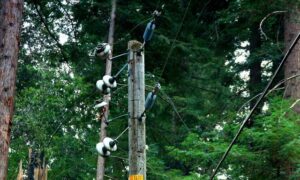July 19, 2019
OP ED, submitted by Nancy Macy, Chair, Environmental Committee for the SLV,
Valley Women’s Club www.valleywomensclub.org.
<nbbm@cruzio.com>, 831/345-1555.
Valley Women’s Club www.valleywomensclub.org.
<nbbm@cruzio.com>, 831/345-1555.

PG&E Fails to Assure Safety from Wildfire – And Now?
The recent fire in Monterey County, caused by PG&E’s failing infrastructure, is no surprise. It underscores PG&E’s decades of egregious failure to provide a safe system -- neither adequately maintaining nor upgrading its weak, antiquated, repeatedly-spliced bare-wire distribution system, or its decrepit transmission system. Both systems were directly implicated in dozens of fires, including 17 of 20 in 2017 alone, as well as the deadly 2018 Camp Fire. The Monterey fire is a prime example of the absurdity of depending on tree removals to prevent wildfire, since there were no trees involved at all and it still burned over 2500 acres. It’s the wires, not the trees.
The Sentinel’s July 1 article on this issue, written by Pulitzer Prize winner, Julie Cart for CalMatters, directly questions whether PG&E is doing enough to provide a fireproof system; its CPUC-approved Wildfire Mitigation Plan “provide(s) scant details, and little evidence to support the companies’ claims that indiscriminately clear-cutting millions of trees … will actually reduce the risk of wildfires.” We will all have to deal with on-going social, financial and environmental costs of this fiasco.
Too many are failing to question PG&E’s massive removal of healthy trees. It is common knowledge that wildfire is the paramount climate change issue impacting the entire State, most especially in PG&E’s forested territory like our mountains. Removing millions of healthy trees is fundamentally bad climate policy.
Confirmed by dozens of reports in other forested areas, PG&E is harassing property owners and removing swaths of healthy trees, even though when (as Cart reports), the CPUC “cautioned the companies against taking out wide swaths … without considering how fire prone the plant or tree is, or whether it’s healthy… (and that) utilities’ plant removal should … (not) denude whole areas and create unintended environmental consequences.”
PG&E’s actions matches its criminally negligent behavior San Bruno gas explosion fiasco, for failing to prioritize the safety of its natural gas system over profit and convenience. This negligence has continued – one disastrous fire after another. PG&E’s demonstrable business model is “Run to Failure,”* delaying repairs and upgrades, awaiting an unsafe system to fail, even though aware of it. This is a scheme to curtail costs, resulting in outages in winter, wildfires in summer, and electrocutions year–round. (*N.Y. Times 3/18/19 https://nyti.ms/2Fj1ksG)
Can the distribution system be made fail-safe? Yes! Safety necessitates replacing thousands of miles of those single strand wires with heavier, insulated wire, so it takes more than a balloon, branch or animal to knock it down.
In addition, true fail-safe can be achieved by adding modern, computerized circuit breakers (aka off-the-shelf-ready high impedance arc fault interrupters) that cut power to a broken wire within one second! Meaning, no fire in summer, no electrocution year-round), and, by sending its location, speeding up repair during a winter outage. There is no CPUC circuit breaker requirement.
Delaying the extensive upgrade needed of the distribution system in Tier 3 utility-associated high fire areas threatens us all. It burdens us by wasting millions of dollars cutting trees. Here, we are guaranteed loss of property value, loss of scenic value, more erosion, loss of slope stability, loss of habitat, loss of threatened species, flooding, increased fire potential, and loss of carbon sequestration exacerbating climate change.
Act now! Demand that the Governor, State Legislature, County, and Cities adopt an ordinance, rule or regulation requiring immediate and extensive infrastructure upgrades as described above, and henceforth limit vegetation management to the level required by law which protects healthy trees – and comply with Public Resources Code (Pages 1-25, Section 4117) to “provide fire prevention regulations that are necessary to meet local conditions of weather, vegetation, or other fire hazards. Such ordinances, rules or regulations may be more restrictive than state statutes in order to meet local fire conditions.”)
More information available on the Valley Women’s Club’s website at www.valleywomensclub.org. On Facebook see PG&E and the SLV: https://www.facebook.com/groups/1171821756315825/
and Citizens for Responsible PG&E Fire Prevention: https://www.facebook.com/groups/ResponsibleFirePrevention/.
Sentinel link
https://www.santacruzsentinel.com/2019/07/07/pge-fails-to-assure-safety-from-wildfire-and-now/